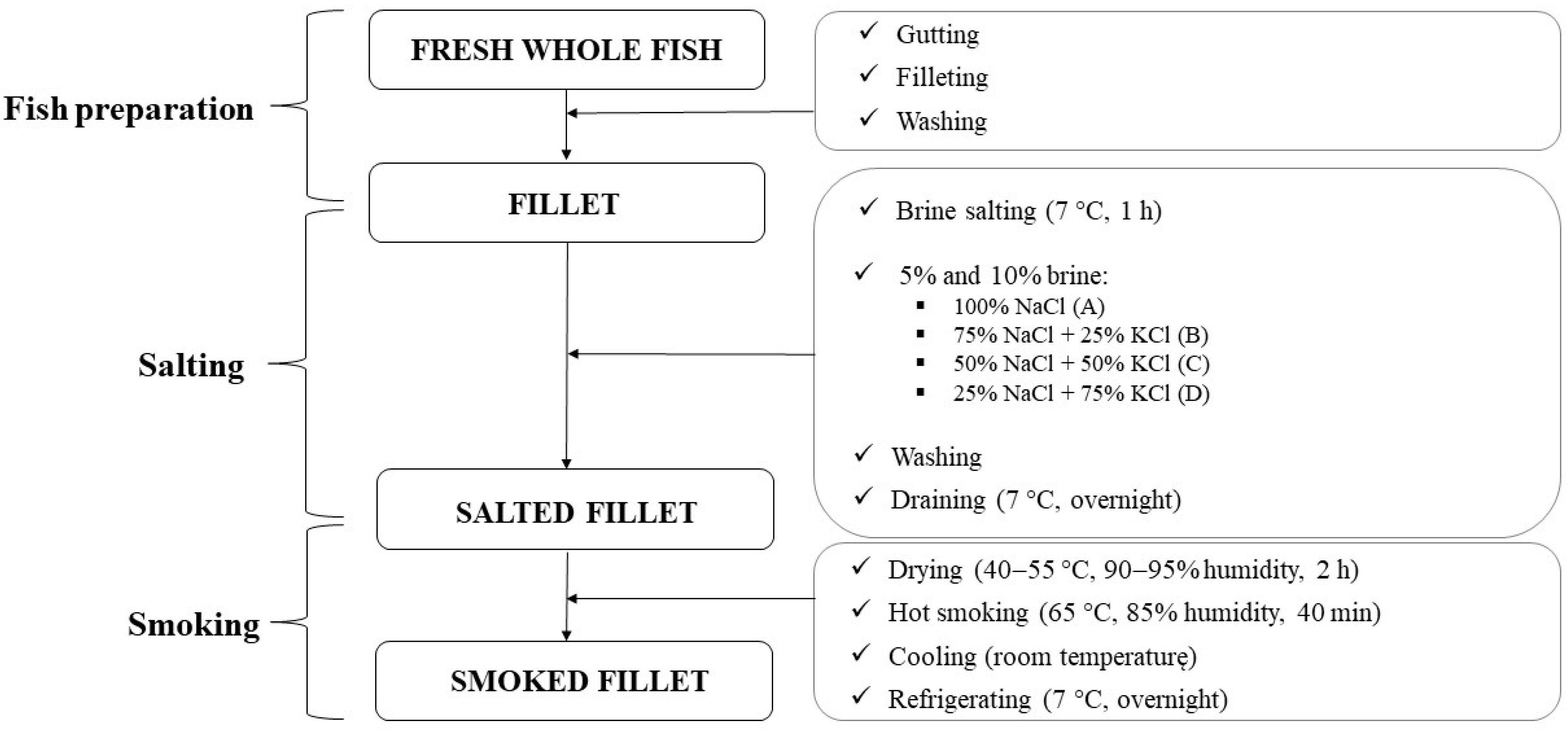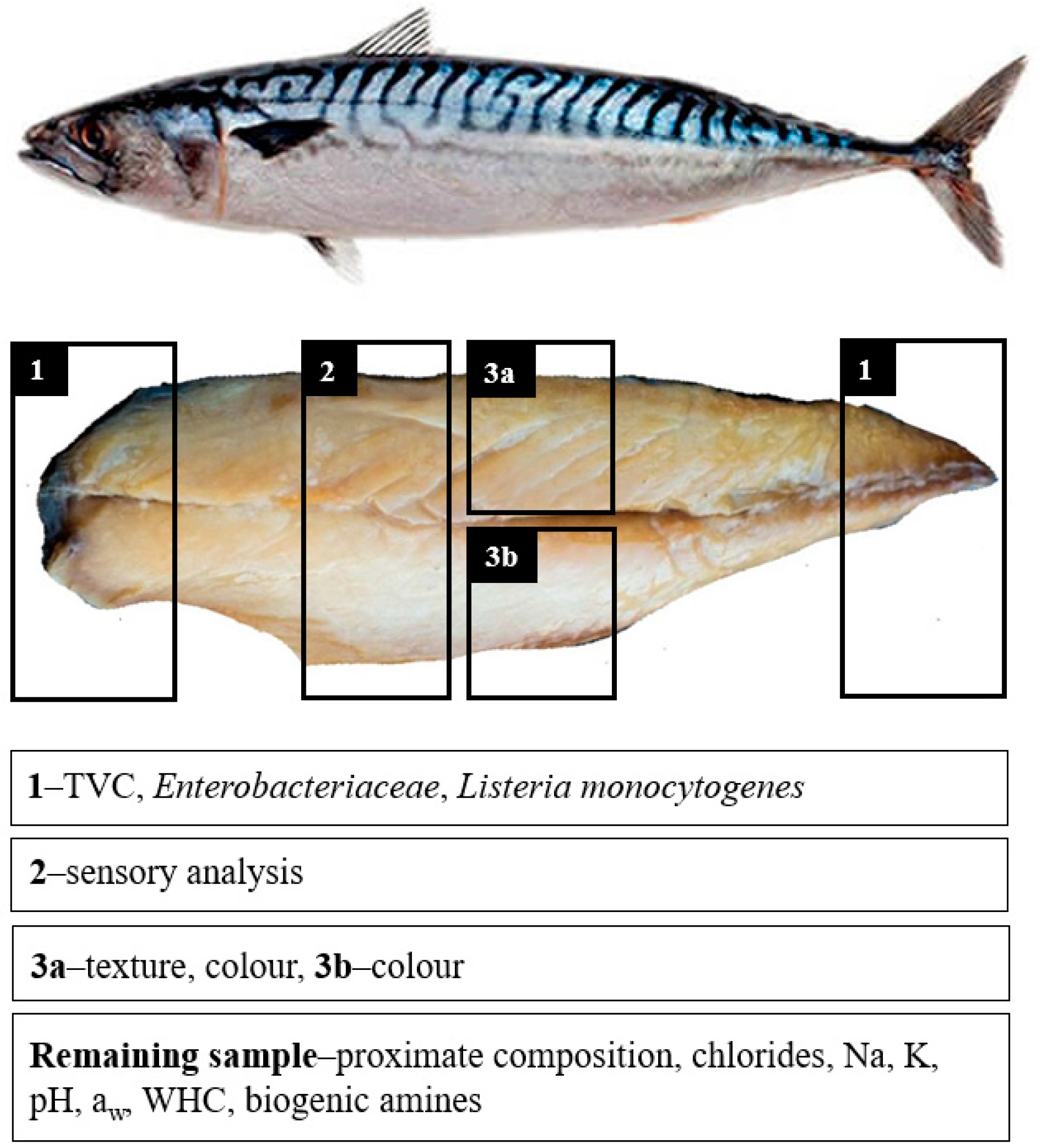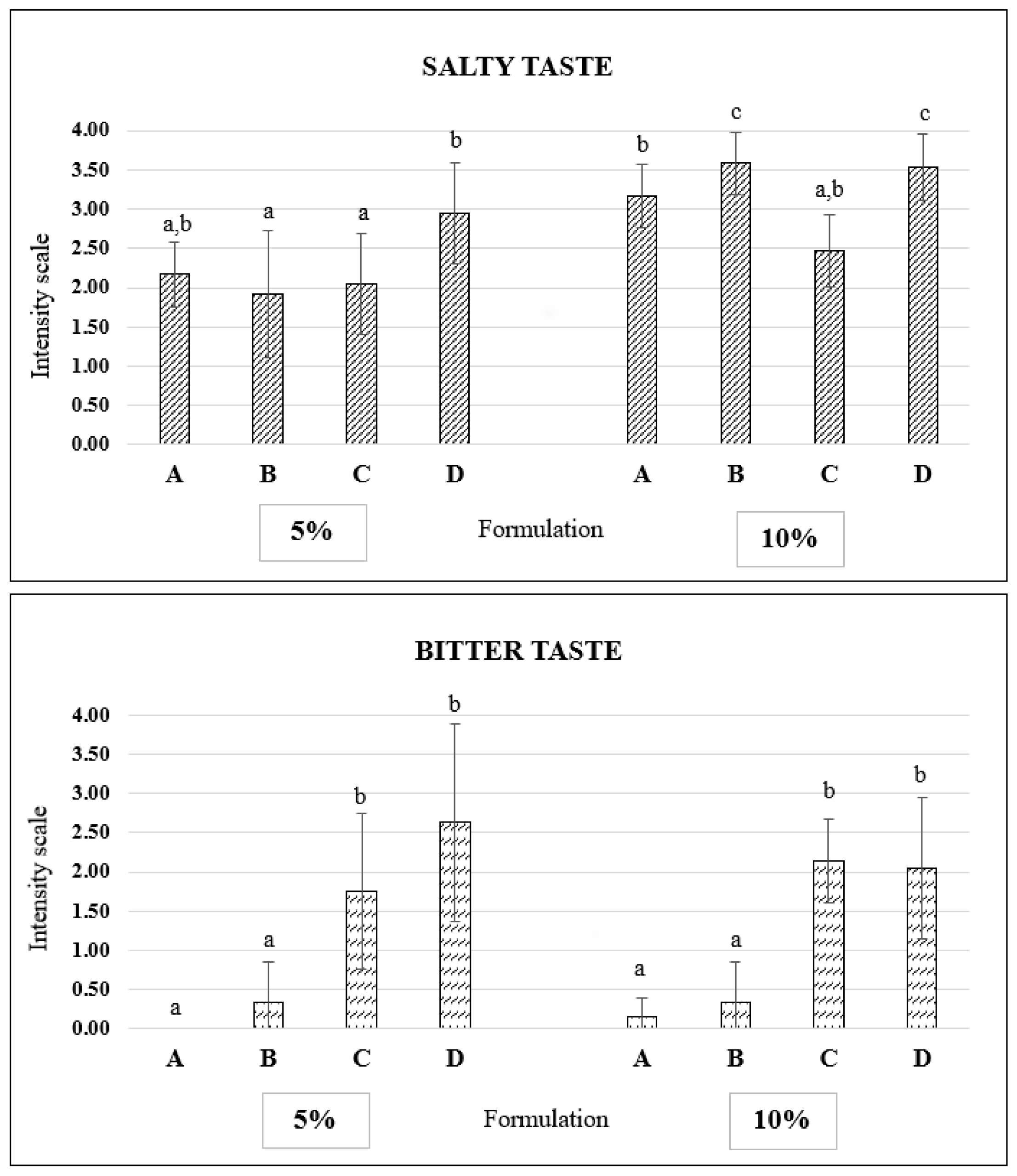The Development of Smoked Mackerel with Reduced Sodium Content
Abstract
:1. Introduction
2. Materials and Methods
2.1. Raw Material
2.2. Salting and Smoking
2.3. Yield
2.4. Proximate Composition (Moisture, Fat, Protein)
2.5. Sodium (Na), Potassium (K), Sodium Chloride (NaCl) and Chloride (Cl−)
2.6. pH, Water Activity (aw) and Water Holding Capacity (WHC)
2.7. Total Viable Counts (TVC), Enterobacteriaceae and Listeria Monocytogenes
2.8. Biogenic Amines (BAs)
2.9. Colour
2.10. Texture
2.11. Sensory Analysis
2.12. Statistical Analysis
3. Results and Discussion
3.1. Yield
3.2. Proximate Composition
3.3. Sodium Chloride (NaCl), Sodium (Na), Potassium (K) and Chloride (Cl−)
3.4. pH, Water Activity (aw) and Water Holding Capacity (WHC)
3.5. Total Viable Counts (TVC), Enterobacteriaceae and Listeria Monocytogenes
3.6. Biogenic Amines (BAs)
3.7. Colour and Texture
3.8. Sensory Analysis
3.9. Market Opportunities and Challenges
4. Conclusions
Author Contributions
Funding
Institutional Review Board Statement
Informed Consent Statement
Data Availability Statement
Acknowledgments
Conflicts of Interest
References
- Statista 2021, Processed Fish & Seafood—Worldwide. (n.d.). Available online: https://www-1statista-1com-1s8fui2kq076e.han3.ue.poznan.pl/outlook/cmo/food/fish-seafood/processed-fish-seafood/worldwid (accessed on 15 July 2021).
- IndexBox. EU—Mackerel (Prepared Or Preserved)—Market Analysis, Forecast, Size, Trends and Insights. 2021. Available online: https://www.indexbox.io/store/eu-mackerel-prepared-or-preserved-market-analysis-forecast-size-trends-and-insights/ (accessed on 15 July 2021).
- Cropotova, J.; Mozuraityte, R.; Standal, I.B.; Rustad, T. A non-invasive approach to assess texture changes in sous-vide cooked Atlantic mackerel during chilled storage by fluorescence imaging. Food Control 2018, 92, 216–224. [Google Scholar] [CrossRef]
- USDA. Nutrient Database. 2021. Available online: https://fdc.nal.usda.gov/ (accessed on 17 July 2021).
- Ferreira, I.; Gomes-Bispo, A.; Lourenço, H.; Matos, J.; Afonso, C.; Cardoso, C.; Castanheira, I.; Motta, C.; Prates, J.A.M.; Bandarra, N.M. The chemical composition and lipid profile of the chub mackerel (Scomber colias) show a strong seasonal dependence: Contribution to a nutritional evaluation. Biochimie 2020, 178, 181–189. [Google Scholar] [CrossRef]
- FDA/EPA 2004 Advice on What You Need to Know About Mercury in Fish and Shellfish. Available online: https://www.fda.gov/food/metals-and-your-food/fdaepa-2004-advice-what-you-need-know-about-mercury-fish-and-shellfish (accessed on 24 August 2021).
- Statista 2021, Consumption if Smoked Mackerel. Available online: https://www-1statista-1com-1s8fui2et0338.han3.ue.poznan.pl/search/?q=smoked+mackerel&qKat=search (accessed on 26 September 2021).
- Kiczorowska, B.; Samolińska, W.; Grela, E.R.; Bik-Małodzińska, M. Nutrient and mineral profile of chosen fresh and smoked fish. Nutrients 2019, 11, 1448. [Google Scholar] [CrossRef] [Green Version]
- World Health Organization. Accelerating Salt Reduction in Europe: A Country Support Package to Reduce Population Salt Intake in the WHO European Region; World Health Organization: Copenhagen, Denmark, 2020; Volume 60. [Google Scholar]
- Liem, D.G.; Miremadi, F.; Keast, R.S.J. Reducing sodium in foods: The effect on flavor. Nutrients 2011, 3, 694–711. [Google Scholar] [CrossRef] [Green Version]
- European Commission. EU Salt Reduction Framework; European Commission: Brussels, Belgium, 2012. [Google Scholar]
- Rybicka, I.; Gonçalves, A.; Oliveira, H.; Marques, A.; Nunes, M.L. Salt reduction in seafood—A review. Food Control 2022, 135, 108809. [Google Scholar] [CrossRef]
- Cepanec, K.; Vugrinec, S.; Cvetković, T.; Ranilović, J. Potassium Chloride-Based Salt Substitutes: A Critical Review with a Focus on the Patent Literature. Compr. Rev. Food Sci. Food Saf. 2017, 16, 881–894. [Google Scholar] [CrossRef] [Green Version]
- Estévez, A.; Camacho, C.; Correia, T.; Barbosa, V.; Marques, A.; Lourenço, H.; Serrano, C.; Sapata, M.; Duarte, M.P.; Pires, C.; et al. Strategies to reduce sodium levels in European seabass sausages. Food Chem. Toxicol. 2021, 153, 112262. [Google Scholar] [CrossRef]
- Muñoz, I.; Guàrdia, M.D.; Arnau, J.; Dalgaard, P.; Bover, S.; Fernandes, J.O.; Monteiro, C.; Cunha, S.C.; Gonçalves, A.; Nunes, M.L.; et al. Effect of the sodium reduction and smoking system on quality and safety of smoked salmon (Salmo salar). Food Chem. Toxicol. 2020, 143, 111554. [Google Scholar] [CrossRef]
- Yanar, Y.; Celik, M.; Akamca, E. Effects of brine concentration on shelf-life of hot-smoked tilapia (Oreochromis niloticus) stored at 4 °C. Food Chem. 2006, 97, 244–247. [Google Scholar] [CrossRef]
- Vaz-Velho, M.; Silva, M.; Pessoa, J.; Gibbs, P. Inactivation by ozone of Listeria innocua on salmon-trout during cold-smoke processing. Food Control 2006, 17, 609–616. [Google Scholar] [CrossRef]
- AOAC (Association of Official Analytical Chemists) International. Food energy—Methods of analysis and conversion factors. In Official Methods of Analysis, 18th ed.; AOAC International: Gaithersburg, ML, USA, 2003. [Google Scholar]
- FAO. Food and Nutrition Paper. Volume 77, pp. 1–87. Available online: http://www.fao.org/uploads/media/FAO_2003_Food_Energy_02.pdf (accessed on 20 July 2021).
- Saint-Denis, T.; Goupy, J. Optimization of a nitrogen analyser based on the Dumas method. Anal. Chim. Acta 2004, 515, 19–198. [Google Scholar] [CrossRef]
- Yoda, T.; Ichinohe, S.; Yokosawa, Y. Rapid analysis of minerals in oysters using microwave decomposition and inductively coupled plasma atomic emission spectrometry. Aquac. Rep. 2021, 19, 100585. [Google Scholar] [CrossRef]
- Kiewlicz, J.; Rybicka, I. Minerals and their bioavailability in relation to dietary fiber, phytates and tannins from gluten and gluten-free flakes. Food Chem. 2020, 305, 125452. [Google Scholar] [CrossRef]
- Sheen, R.T.; Kahler, H.L. Effects of Ions on Mohr Method for Chloride Determination. Ind. Eng. Chem. Anal. Ed. 1938, 10, 628–629. [Google Scholar] [CrossRef]
- Cardoso, C.M.L.; Mendes, R.; Nunes, M.L. Instrumental texture and sensory characteristics of cod frankfurter sausages. Int. J. Food Prop. 2009, 12, 625–643. [Google Scholar] [CrossRef]
- Alves, S.P.; Alfaia, C.M.; Škrbić, B.D.; Živančev, J.R.; Fernandes, M.J.; Bessa, R.J.B.; Fraqueza, M.J. Screening chemical hazards of dry fermented sausages from distinct origins: Biogenic amines, polycyclic aromatic hydrocarbons and heavy elements. J. Food Compos. Anal. 2017, 59, 124–131. [Google Scholar] [CrossRef]
- Careche, M.; Barroso, M. Instrumental texture measurement in fishery products. In Quality, Safety and Authenticity; Rehbein, H., Oehlenschlager, J., Eds.; Wiley-Blackwell: Oxford, UK, 2009; pp. 214–239. [Google Scholar]
- Meilgaard, M.; Civille, G.V.; Carr, B.T. Sensory Evaluation Techniques, 5th ed.; CRC Press Taylor & Francis Group: New York, NY, USA, 2016; 589p. [Google Scholar]
- Menezes, M.M.; Lopes, C.T.; Nogueira, L.D.S. Impacto de intervenções educativas na redução das complicações diabéticas: Revisão sistemática. Rev. Bras. Enferm. 2016, 69, 773–784. [Google Scholar] [CrossRef] [Green Version]
- Bienkiewicz, G.; Tokarczyk, G.; Czerniejewska–Surma, B.; Suryn, J. Changes in the EPA and DHA content and lipids quality parameters of rainbow trout (Oncorhynchus mykiss, Walbaum) and carp (Cyprinus carpio, L.) at individual stages of hot smoking. Heliyon 2019, 5, e02964. [Google Scholar] [CrossRef] [Green Version]
- Kristinsd, T.B.; Kristinsson, H.G.; Karlsd, M.G. Effect of brining and frozen storage on physicochemical properties of well-fed Atlantic mackerel (Scomber scombrus) intended for hot smoking and canning. LWT-Food Sci. Technol. 2016, 72, 199–205. [Google Scholar] [CrossRef]
- Kunachowicz, H.; Nadolna, I.; Przygoda, B.; Iwanow, K. Tabele Składu i Wartości Odżywczej Żywności; Food Composition Tables; PZWL: Warsaw, Poland, 2005. (In Polish) [Google Scholar]
- Helsedirektoratet. 2016. Available online: https://www.helsedirektoratet.no/english/salt-and-the-salt-partnership (accessed on 18 July 2021).
- European Parliament & Council Regulation (EC) No 1924/2006 of the European Parliament and the of the Council on nutrition and health claims made on foods. Off. J. Eur. Union 2006, 404, 9–25.
- Whelton, P.K. Sodium, potassium, blood pressure, and cardiovascular disease in humans. Curr. Hypertens. Rep. 2014, 16, 465. [Google Scholar] [CrossRef] [PubMed]
- He, F.J.; MacGregor, G.A. Beneficial effects of potassium. Br. Med. J. 2001, 323, 497–501. [Google Scholar] [CrossRef] [PubMed]
- Turck, D.; Bresson, J.-L.; Burlingame, B.; Dean, T.; Fairweather-Tait, S.; Heinonen, M.; Hirsch-Ernst, K.I.; Mangelsdorf, I.; McArdle, H.; Neuhäuser-Berthold, M.; et al. Dietary reference values for potassium. EFSA J. 2016, 14, e04592. [Google Scholar] [CrossRef]
- Bellés, M. Commission Regulation (EU) No 1129/2011 of 11 November 2011 amending Annex II to Regulation (EC) No 1333/2008 of the European Parliament and of the Council by establishing a Union list of food additives. J. Sci. Food Agric. 2019, 99, 407–414. [Google Scholar] [CrossRef]
- Turck, D.; Castenmiller, J.; de Henauw, S.; Hirsch-Ernst, K.I.; Kearney, J.; Knutsen, H.K.; Maciuk, A.; Mangelsdorf, I.; McArdle, H.J.; Pelaez, C.; et al. Dietary reference values for chloride. EFSA J. 2019, 17, e05779. [Google Scholar] [CrossRef]
- Khodanazary, A. Quality characteristics of refrigerated mackerel Scomberomorus commerson using gelatin-polycaprolactone composite film incorporated with lysozyme and pomegranate peel extract. Int. J. Food Prop. 2019, 22, 2056–2070. [Google Scholar] [CrossRef] [Green Version]
- European Parliament & Council Regulation (EC) No 2073/2005 of 15 November 2005 on microbiological criteria for foodstuffs. Off. J. Eur. Union 2005, 338, 1–26.
- Ekonomou, S.I.; Bulut, S.; Karatzas, K.A.G.; Boziaris, I.S. Inactivation of Listeria monocytogenes in raw and hot smoked trout fillets by high hydrostatic pressure processing combined with liquid smoke and freezing. Innov. Food Sci. Emerg. Technol. 2020, 64, 102427. [Google Scholar] [CrossRef]
- European Parliament & Council Regulation (EC) No 1019/2013 of 23 October 2013 amending Annex I to Regulation (EC) n°2073/2005 as regards histamine in fishery products. Off. J. Eur. Union 2013, 9, 46–47.
- Iko Afé, O.H.; Saegerman, C.; Kpoclou, Y.E.; Douny, C.; Igout, A.; Mahillon, J.; Anihouvi, V.B.; Hounhouigan, D.J.; Scippo, M.L. Contamination of smoked fish and smoked-dried fish with polycyclic aromatic hydrocarbons and biogenic amines and risk assessment for the Beninese consumers. Food Control 2021, 126, 108089. [Google Scholar] [CrossRef]
- Pawul-Gruba, M.; Michalski, M.; Osek, J. Determination of histamine in fresh and smoked fish commercially available in Poland. Bull. Vet. Inst. Pulawy 2014, 58, 301–304. [Google Scholar] [CrossRef] [Green Version]
- Schubring, R. Thermal stability, texture, liquid holding capacity and colour of smoked salmon on retail level. Thermochim. Acta 2006, 445, 168–178. [Google Scholar] [CrossRef]
- Fuentes, A.; Fernández-Segovia, I.; Serra, J.A.; Barat, J.M. Effect of partial sodium replacement on physicochemical parameters of smoked sea bass during storage. Food Sci. Technol. Int. 2012, 18, 207–217. [Google Scholar] [CrossRef] [PubMed]
- Rizo, A.; Fuentes, A.; Fernández-Segovia, I.; Barat, J.M. Development of a novel smoke-flavoured trout product: An approach to sodium reduction and shelf life assessment. J. Food Eng. 2017, 211, 22–29. [Google Scholar] [CrossRef]
- Messina, C.M.; Arena, R.; Ficano, G.; La Barbera, L.; Morghese, M.; Santulli, A. Combination of Freezing, Low Sodium Brine, and Cold Smoking on the Quality and Shelf-Life of Sea Bass (Dicentrarchus labrax L.) Fillets as a Strategy to Innovate the Market of Aquaculture Products. Animals 2021, 11, 185. [Google Scholar] [CrossRef]
- Osheba, A.S. Technological attempts for production of low sodium smoked herring fish (Renga). Adv. J. Food Sci. Technol. 2013, 5, 695–706. [Google Scholar] [CrossRef]
- Anastasio, A.; Marrone, R.; Chirollo, C.; Smaldone, G.; Attouchi, M.; Adamo, P.; Sadok, S.; Pepe, T. Swordfish steaks vacuum-packed with Rosmarinus officinalis. Ital. J. Food Sci. 2014, 26, 390–397. [Google Scholar]
- Statista 2021. Available online: https://www.statista.com/statistics/820953/per-capita-consumption-of-seafood-worldwide/ (accessed on 23 July 2021).
- Ourworldindata 2021. Available online: https://ourworldindata.org/grapher/fish-and-seafood-consumption-per-capita (accessed on 21 July 2021).
- Steingoltz, M.; Picciola, M.; Wilson, R. Consumer Health Claims 3.0: The Next Generation of Mindful Food Consumption. 2018. Available online: https://www.lek.com/insights/ei/next-generation-mindful-food-consumption (accessed on 19 July 2021).



| Formulations | Yield | Moisture | Protein | Fat | Na | K | NaCl | Cl− | |
|---|---|---|---|---|---|---|---|---|---|
| Brine | Formulation | (%) | (g/100 g) | (g/100 g) | (g/100 g) | (g/100 g) | (g/100 g) | (g/100 g) | (g/100 g) |
| 5% | A | 80.0 ± 1.20 | 59.9 ± 1.80 | 28.4 ± 0.54 a,b | 10.4 ± 0.14 | 0.50 ± 0.02 a | 0.50 ± 0.01 a | 1.26 ± 0.05 a | 1.37 ± 0.03 a |
| B | 78.0 ± 2.09 | 61.2 ± 1.90 | 30.2 ± 1.18 b | 9.44 ± 0.75 | 0.45 ± 0.02 a | 0.82 ± 0.02 d | 1.14 ± 0.04 a | 1.51 ± 0.04 a | |
| C | 79.4 ± 1.33 | 59.6 ± 1.40 | 28.4 ± 1.14 a,b | 9.16 ± 0.61 | 0.36 ± 0.02 b | 1.10 ± 0.05 b | 0.89 ± 0.05 b | 1.61 ± 0.16 a | |
| D | 80.7 ± 2.09 | 59.2 ± 1.98 | 27.9 ± 0.49 a | 9.84 ± 0.11 | 0.22 ± 0.01 c | 1.37 ± 0.04 c | 0.56 ± 0.03 c | 1.56 ± 0.24 a | |
| 10% | A | 80.8 ± 0.95 | 60.1 ± 0.45 | 27.7 ± 0.26 a | 9.32 ± 0.35 | 1.04 ± 0.05 e | 0.51 ± 0.02 a | 2.60 ± 0.13 e | 2.67 ± 0.11 b |
| B | 80.8 ± 1.90 | 59.2 ± 0.26 | 28.3 ± 0.61 a,b | 9.44 ± 0.68 | 0.81 ± 0.04 d | 1.08 ± 0.06 b | 2.02 ± 0.11 d | 2.74 ± 0.32 b | |
| C | 81.0 ± 1.58 | 57.5 ± 1.59 | 27.7 ± 0.46 a | 10.3 ± 0.76 | 0.48 ± 0.01 a | 1.44 ± 0.06 c | 1.19 ± 0.03 a | 2.32 ± 0.13 b | |
| D | 77.7 ± 2.85 | 58.4 ± 1.46 | 28.7 ± 0.60 a,b | 9.53 ± 0.41 | 0.31 ± 0.03 b | 2.01 ± 0.10 e | 0.77 ± 0.06 b | 2.49 ± 0.34 b | |
| Formulations | pH | aw | WHC | Cadaverine | Spermidine | |
|---|---|---|---|---|---|---|
| Brine | Formulation | (-) | (-) | (%) | (mg/kg) | (mg/kg) |
| 5% | A | 6.11 ± 0.06 | 0.953 ± 0.004 a,b | 59.0 ± 2.86 | 4.54 ± 1.41 | 0.96 ± 0.14 a |
| B | 6.13 ± 0.11 | 0.955 ± 0.002 a | 61.8 ± 5.25 | 5.26 ± 1.18 | 2.43 ± 1.12 a,b | |
| C | 6.15 ± 0.02 | 0.955 ± 0.001 a | 59.2 ± 4.64 | 4.54 ± 2.26 | 2.62 ± 0.28 a,b | |
| D | 6.18 ± 0.05 | 0.954 ± 0.003 a,b | 62.6 ± 4.00 | 4.61 ± 2.38 | 2.73 ± 0.61 b | |
| 10% | A | 6.08 ± 0.07 | 0.940 ± 0.000 d | 65.0 ± 3.52 | 5.12 ± 1.33 | 1.42 ± 0.53 a,b |
| B | 6.16 ± 0.04 | 0.946 ± 0.001 c | 61.8 ± 1.04 | 3.87 ± 0.48 | 1.01 ± 0.17 a | |
| C | 6.16 ± 0.10 | 0.949 ± 0.001 a,b,c | 57.5 ± 5.54 | 4.45 ± 1.62 | 1.24 ± 0.40 a,b | |
| D | 6.19 ± 0.06 | 0.948 ± 0.004 b,c | 61.3 ± 2.43 | 3.46 ± 2.22 | 1.26 ± 0.83 a,b | |
| Formulations | Colour | Texture | ||||||
|---|---|---|---|---|---|---|---|---|
| Brine | Formulation | L* | a* | b* | Hardness (N) | Springiness (-) | Cohesiveness (-) | Chewiness (N) |
| 5% | A | 55.6 ± 1.2 b | 2.4 ± 1.0 | 20.0 ± 2.8 | 39.8 ± 3.70 | 0.52 ± 0.02 | 0.40 ± 0.02 | 8.40 ± 1.12 |
| B | 52.7 ± 3.0 a,b | 3.0 ± 2.2 | 19.0 ± 1.6 | 37.0 ± 2.65 | 0.48 ± 0.01 | 0.43 ± 0.02 | 7.89 ± 0.41 | |
| C | 52.5 ± 1.8 a,b | 2.8 ± 1.9 | 20.0 ± 2.6 | 37.4 ± 2.56 | 0.47 ± 0.02 | 0.41 ± 0.02 | 7.20 ± 0.95 | |
| D | 54.2 ± 3.6 a,b | 3.0 ± 2.5 | 20.0 ± 4.3 | 38.3 ± 2.04 | 0.49 ± 0.06 | 0.40 ± 0.01 | 7.55 ± 0.88 | |
| 10% | A | 49.2 ± 5.1 a | 3.3 ± 2.3 | 18.0 ± 3.8 | 39.2 ± 3.56 | 0.51 ± 0.05 | 0.41 ± 0.01 | 8.57 ± 0.76 |
| B | 51.0 ± 2.6 a,b | 2.6 ± 1.5 | 17.0 ± 2.4 | 32.7 ± 3.46 | 0.50 ± 0.04 | 0.43 ± 0.01 | 7.37 ± 0.74 | |
| C | 52.0 ± 2.7 a,b | 2.5 ± 1.5 | 18.0 ± 3.8 | 32.8 ± 1.20 | 0.45 ± 0.06 | 0.38 ± 0.03 | 7.91 ± 1.03 | |
| D | 53.1 ± 3.8 a,b | 1.6 ± 1.5 | 19.0 ± 4.7 | 37.2 ± 4.44 | 0.50 ± 0.02 | 0.40 ± 0.04 | 7.51 ± 0.44 | |
Publisher’s Note: MDPI stays neutral with regard to jurisdictional claims in published maps and institutional affiliations. |
© 2022 by the authors. Licensee MDPI, Basel, Switzerland. This article is an open access article distributed under the terms and conditions of the Creative Commons Attribution (CC BY) license (https://creativecommons.org/licenses/by/4.0/).
Share and Cite
Rybicka, I.; Silva, M.; Gonçalves, A.; Oliveira, H.; Marques, A.; Fernandes, M.J.; Fernandes, M.H.; Alfaia, C.M.; Fraqueza, M.J.; Nunes, M.L. The Development of Smoked Mackerel with Reduced Sodium Content. Foods 2022, 11, 349. https://doi.org/10.3390/foods11030349
Rybicka I, Silva M, Gonçalves A, Oliveira H, Marques A, Fernandes MJ, Fernandes MH, Alfaia CM, Fraqueza MJ, Nunes ML. The Development of Smoked Mackerel with Reduced Sodium Content. Foods. 2022; 11(3):349. https://doi.org/10.3390/foods11030349
Chicago/Turabian StyleRybicka, Iga, Marlene Silva, Amparo Gonçalves, Helena Oliveira, António Marques, Maria José Fernandes, Maria Helena Fernandes, Cristina Mateus Alfaia, Maria João Fraqueza, and Maria Leonor Nunes. 2022. "The Development of Smoked Mackerel with Reduced Sodium Content" Foods 11, no. 3: 349. https://doi.org/10.3390/foods11030349
APA StyleRybicka, I., Silva, M., Gonçalves, A., Oliveira, H., Marques, A., Fernandes, M. J., Fernandes, M. H., Alfaia, C. M., Fraqueza, M. J., & Nunes, M. L. (2022). The Development of Smoked Mackerel with Reduced Sodium Content. Foods, 11(3), 349. https://doi.org/10.3390/foods11030349








